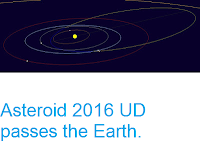Asteroid (138852) 2000 WN10 passed the Earth at a distance of 18 950 000
km (about 49.3 times the distance between the Earth and the
Moon or 12.7% of the distance between the Earth and the Sun), slightly before 12.40 pm GMT on Thursday 10 November 2016. There was
no danger of the asteroid hitting us, though if were to do so it would
present a significant threat. (138852) 2000 WN10 is estimated to be
between 170 and 540 m in diameter, and an asteroid of this size would be
expected to pass directly through the atmosphere, striking the Earth's
surface and creating a crater 3-8 km in diameter, as well as causing
devastation over a wide area and global climatic effects that would
potentially last for decades.
The calculated orbit of (138852) 2000 WN10. Minor Planet Center.
(138852) 2000 WN10 was discovered on 20 November 2000 by the Lincoln Near-Earth Asteroid Research project at the Massachusetts Institute of Technology.
The designation 2000 WN10 implies that it was the 263rd asteroid
discovered in the second half of November 2000 (period 2000 W),
while 138852 indicates that it was the 138 852nd asteroid discovered
overall (asteroids are not given this longer designation immediately, to
ensure that numbered objects are genuine asteroids that have not been
previously described).
(138852) 2000 WN10 has a 366 day orbital period and an eccentric orbitat
an angle of 21.5° to the plane of the Solar System that takes it from 0.70 AU
from the Sun (i.e. 70% of the average distance at which the Earth orbits
the Sun, roughly the distance at which Venus orbits) to 1.30 AU from
the Sun (i.e. 130% of the average distance at which the Earth orbits the
Sun, inside the orbit of the planet Mars). It is therefore classed as
an Apollo Group Asteroid (an asteroid that is on average further from
the Sun than the Earth, but which does get closer). However the
inclination at which the asteroid orbits means it seldom draws close to
any planet other than Earth.
Because the orbital period of (138852) 2000 WN10 is almost exactly one
Earth year, close encounters between the planet and the asteroid are a
predictable annual event. This occurred on 10 Novemberfor the first time this year
and will continue to do so till 2022. From 2012-2015 the asteroid passed
us on 11 November, and in 2023 it will again pass us on 11 November.
See also...
Follow Sciency Thoughts on Facebook.







